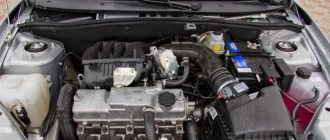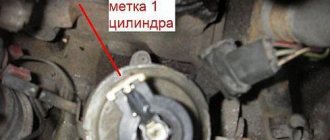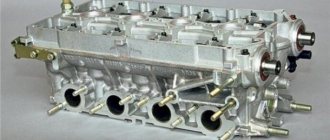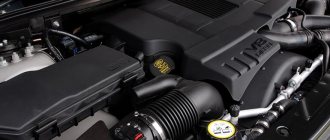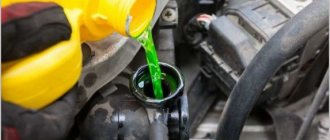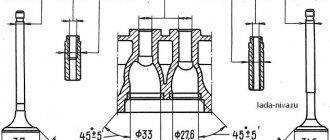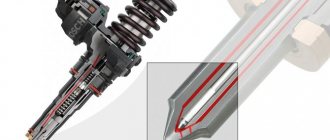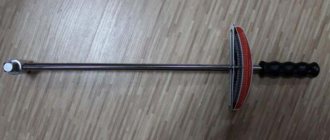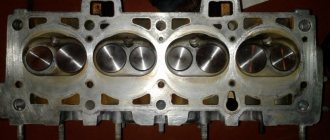Engine of the new Lada Kalina 2
Lada Kalina Sport 1.6 Logbook Alternator belt tightening
The new Lada Kalina is equipped with three engine versions: 87, 98 and 106 horsepower. All of them have 4 cylinders and a volume of 1.6 liters.
The first engine is the VAZ 21116, which is an improved version of the classic eight-valve engine.
More recently, it acquired a new connecting rod and piston group, as well as several other improvements, which increased power and torque.
This engine is significantly superior to its predecessor 11183-50 and even more so to the G8 engine (21114).
The unfortunate fact is that belt weights remain a welcome feature. It was not returned to this engine due to economic considerations - the Indian Bosch generator is cheaper than the domestic one.
Engine 21116 is installed on basic versions of Kalina together with a manual transmission 2181. The gearbox is essentially a new mechanism, which has retained only a set of gears from its predecessors, and everything else is new or updated
It is important to note that the drive from the lever to the gear selector has become a cable drive (made in Japan). This allows for increased shift clarity
No less important was the fact that reverse gear is engaged again by moving to the right and backwards.
The second engine is a 16-valve VAZ 21126. It is known from Priora and Granta with automatic transmission.
The automatic transmission was inherited by Kalina 2. Despite its archaic nature, this gearbox was liked by many car enthusiasts due to its reliability. It is worth noting that the Jatco gearbox works well in China on the Nissan Micra.
Over time, the Jatco automatic transmission will be calibrated for the latest version of the engine. The new powerful engine 21127 was presented to the public for the first time on Kalina 2. But for now Kalinas are equipped with a 106-horsepower engine only with a manual transmission.
The 27th has one feature - the length of the intake manifold can vary. At low speeds, the air moves to the cylinders along a long path, and when the speed increases, thanks to the actuation of the damper, the air comes from a small part of the receiver.
Due to the fact that air resistance is reduced in this case, greater engine responsiveness is achieved. For domestic automakers, the use of such “resonant supercharging” is a serious step forward. Although it is worth saying that three intake chambers have been used in the world for a long time.
For the first time in the history of the domestic automobile industry, truly high-quality and modern mechanisms are installed on board cars, thanks to which the ride quality reaches a completely new level.
Is it worth buying a Kalina with a VAZ-11183 8 valve engine
Details Category: Test drive Published 06/20/2019
Self-replacement of the Lada Kalina thermostat step-by-step instructions
Today we will share a review from a real owner - is it worth buying a Lada Kalina with an eight-valve 1.6 VAZ-11183 engine.
Today we will share a review from the real owner of a 2012 Lada Kalina car equipped with a VAZ-11183 engine.
The VAZ-11183 engine is the basic and simplest one that was available on first-generation Lada Kalina cars. Nowadays, a lot of such cars are sold on the secondary market, so we decided to publish a review from a real owner - is it worth buying such a car?
Minuses
11183 – 8-valve engine with a volume of 1.6 liters and a power of 82 hp. It is equipped with a distributed injection system. The design of the engine is extremely simple - there are no phase shifters, adjustable intake, etc. There are no hydraulic compensators, so valve adjustment is required periodically (usually once every 30 thousand km). This is one of the disadvantages of this engine - periodically you will have to spend time and money adjusting the valves.
Another disadvantage is the low power - 82 hp. enough for confident driving around the city, but on the highway (especially if there are several people in the cabin), it’s better to plan overtaking well - the dynamics are not enough for quick maneuvers.
Also, as a minus, one can note the significant vibration and noise load of this engine.
pros
Now about the advantages, of which there are also many. Perhaps the most important and main plus is that the VAZ-11183 engine does not bend the valve when the timing belt breaks. Considering the quality of the components, a timing belt break on Kalina is a lottery in which you cannot guess when it will happen. For example, the author of this article broke his timing belt before reaching 60 thousand km. At the same time, not a single valve was damaged - replacing the timing belt along with the roller and work at the nearest car service center cost 2,000 rubles.
The second plus is low transport tax. For example, in Tatarstan, since the engine power is less than 100 hp, the tax is 10 rubles per hp. – 820 rubles per year.
The third plus is efficiency. In city mode, you can easily meet 9 liters per 100/km; on the highway, consumption in cruising mode does not exceed 6 liters.
The fourth plus is maintainability. This engine can be serviced and repaired in almost any village, and many operations can be performed independently (changing oil, filters, spark plugs, etc.).
Conclusion
To summarize, we can say that the Lada Kalina with the VAZ-11183 engine is more suitable for a calm, measured drive. If you need more dynamics, it is better to choose a version with a 16-valve engine. It will be more interesting in motion, but the transport tax will be more expensive, and if the timing belt breaks, repairs can cost a pretty penny.
Summing up
It is quite difficult to unequivocally answer the question which engine is better.
If you are interested in power, quick acceleration and quiet driving, then it is better to choose a 16-valve engine. It consumes less gasoline and does not require valve adjustments.
If low maintenance and unpretentiousness are important to you, then your choice is an 8-valve engine . This option is better suited for those motorists who prefer to maintain and repair their car themselves.
Engine malfunctions and repairs 11194
Lada Kalina engine 1.4 16 valves 11194 is a simplified version of the Priora engine and an evolution of the well-known modified, redesigned engine 21083. It differs from the Priora engine in volume, power indicators and torque for the worse. The engine itself is an injector inline 4 cylinder with overhead camshafts, the timing belt has a belt drive. The service life of the 11194 engine, according to the manufacturer's data, has increased, relative to previous AvtoVAZ developments, by 50 thousand and is now 200 thousand km, in practice it is about that. On the technical side, the 194 engine differs from the 126 (Priora) by smaller diameter pistons (it was 82 mm became 76.5 mm), due to this the volume decreased from 1.6 liters. up to 1.4 l. and a slightly smaller combustion chamber, due to these transformations the low-end torque disappeared, the engine only starts at 2000 rpm and for normal movement it needs to be constantly turned, so the conceived idea of an economical engine did not work. In addition, the VAZ 11194 engine bends the valves, the rollers fall apart, the pump gets stuck, the timing belt falls off, and we end up with expensive repairs. In order to avoid problems, every 60 thousand km it is necessary to change the timing belt with a roller and the pump. In addition, this motor can knock and make various sounds, get warm or not warm, the speed can fluctuate, stall, etc. What is the reason and what to do in these cases, see HERE in the “Faults and Repairs” section. At the moment, engine 11194 has been discontinued and is available only for aftermarket use; it is not available on new cars.
About engines for LADA Kalina
A small family of AvtoVAZ cars, Lada Kalina, appeared in 2008 and includes a sedan, station wagon and hatchback.
The model was created on the basis of the VAZ 2108 and many units, including engines, were borrowed from it. Engine VAZ 21114/11183 1.6l (2114 1.6)
The VAZ 21114/11183 power unit became an evolutionary development of the 1.5-liter 2111 engine, but with an oversized cylinder block and an increased piston stroke, due to which the volume of the entire engine increased to 1.6 liters.
The new engine has increased eco-standards, and can also be called reliable and unpretentious, unlike the base 2111. Benefits in terms of traction and elasticity have been noted.
The engine is recognized under several names: 21114, 11183, 2114 and motor-Kalina, but the difference is only in the place of assembly.
The VAZ 21114/11183 four-cylinder in-line injection engine received an overhead camshaft and a timing belt drive.
The lack of hydraulic compensators forces the valves to be periodically adjusted.
If the belt breaks, the valve does not bend; in the sports version of the camshaft there is such a chance.
The disadvantages are generally the same as those of the VAZ 2111, that is, the same noise and diesel engine, tripping, temperature instability, etc. 3
Engine VAZ 11194 1.4 16V
The VAZ 11194 power unit with 16 valves became a simplified version of the Priora engine and an evolution of the VA 21083 in a modified version.
Unlike the base engine, the VAZ 11194 1.4 16V differs in volume, power and worse torque.
The engine life has increased by 50 thousand kilometers compared to its predecessors and reaches 200 thousand km.
In the technical part, the pistons have changed, decreasing in diameter to 76.5 mm, which made it possible to reduce the volume of the engine and combustion chamber. This idea of transformation led to the fact that the torque at the bottom disappeared and the engine starts only from 2000 rpm and requires constant torque.
When the timing belt breaks, the valves bend, the rollers fall apart, and if the pump jams, the timing belt falls off, which leads to expensive repairs.
The VAZ 11194 is not without various noises and knocks, problems with temperature, floating speed and other things. To date, the VAZ 11194 1.4 16V engine has been discontinued. 2
Engine Priora 21126 1.6 16 valves
The 21126 power unit was a continuation of the VAZ 21124, but with a lighter Federal Mogul SPG. The valve wells have become smaller, and the timing belt drive has received an electric tensioner. The cylinder block is surface-finished and honed to Federal Mogul's strict standards.
The 21126 1.6 4-cylinder injection engine received an overhead camshaft and a belt timing mechanism.
The disadvantages of the engine include loss of power, unstable operation and a problematic timing belt. The culprits of such malfunctions are defects in fuel pressure, poor timing, defects in sensors, throttle valve and air pumping with hoses.
Bubbling and diesel engine Lada Kalina 1.6 8cl
After purchasing my Kalina two years ago, it was very unusual for me to listen to a strange sound when the engine was running, especially during sub-zero temperatures. I remember all my previous cars, there was no such problem, and so at first I thought that there was something wrong with the car. But when I listened to the sound of the other owners, I realized that all 8-valve engines on the Lada Kalina work this way.
By the way, in the summer this bubbling is not so pronounced and is noticeable only in the first minutes after starting the engine, and even then it is not a very pronounced sound. But in winter you have to listen to diesel quite often, especially in the morning in good frosts, until the engine warms up to at least 50 degrees. Then, gradually these sounds become quieter and when they reach 90 degrees, for me personally, they go away completely!
At one time, this problem was discussed on the Kalina Club forum, but there, in fact, many owners were in a panic, drove their cars to official dealers for service, asked to fix this problem under warranty, etc. But in almost all cases they were told that this is the design of this 1.6 8-valve engine and nothing can be done about it. All you have to do is get used to it, because this obviously doesn’t affect the traction and the other parameters of the power unit either! So why bother yourself with incomprehensible questions and doubts? As they say, don't stop the machine from working!
Although there are also owners who nevertheless decided to get rid of this bubbling and dismantled their engines, some at home in garages, and some in a car service center, I never heard from them later whether they managed to get rid of diesel, or everything remained in place and this strange sound did not disappear anywhere. Maybe there are drivers here who have solved this problem, many are wondering what exactly is the design flaw of this 8-valve engine? I heard an opinion that this strange sound occurs on a cold engine due to the fact that the piston stroke in the 1.6 modification has increased, and accordingly, while the oil is cold, it does not have time to properly lubricate the piston and this grunting occurs! I wonder if these are just assumptions or are there lucky people who managed to get rid of this illness from Kalina? Share your experience!
Lada Kalina 1st generation
Fuel consumption rate per 100 km
In the first two years, AvtoVAZ had to recall a number of cars back to the plant for modification and repair due to a defect in the assembly. This happened three times: due to a defect in the steering column, incorrect casting of the steering housing and a defect in the engine mounts. In the basic configuration, the standard power unit was a 1.6-liter engine producing 81 hp. The maximum speed to which such a car accelerates is 160 km/h, and its consumption is 10.2 liters in the city and 6.6 liters on the highway. Later, a 1.4 89 hp engine was added to it. and 1.6 98 hp The maximum speed of such units is 160 and 183 km/h, respectively. Consumption per 100 km in the city is 9.6-9.7 liters and on the highway 6.3-6.4 liters.
Real gas consumption
- Dmitry, Vologda. Lada (VAZ) Kalina 1.6 MT 2009 When I took the car, of course, I didn’t expect anything supernatural, since I know our auto industry quite well. But I didn’t expect such shortcomings either. During the first thousand kilometers the horn broke. The build quality couldn't be worse. And the consumption is a bit high - 10-11 liters in the city, 7 liters on the highway.
- Sergey, Kursk. I originally bought the car for my mother’s dacha, but later I got behind the wheel. Overall not bad, but too many shortcomings, although roomy. After a month and a half, the doors began to creak terribly. Now the steering rack has already started to act up. The engine is good, its consumption is 8.5 liters per 100 km. Our model is 2007 with a 1.6 MT engine.
- Valery, Moscow. 3 years after the purchase, I can say that Kalina is a good car. Especially with such a configuration for such money (1.4 MT engine, manufactured in 2011). The interior is spacious and the paint job is also good. The only bad thing is that the trunk lid closes tightly, with some effort. Plus, the rubber bands on the doors are bad - they leak when it rains. Consumption in the city is 10 liters, on the highway 6.5-7 liters.
- Alexander, Ufa. Lada Kalina 1.6 MT 2006. The car is good only in terms of engine and spaciousness. Its consumption is average - it consumes up to 7 liters per 100 km on the highway. In the city, in quiet mode, 10-10.5 liters are consumed. In terms of reliability, everything is bad here. In the first six months I stood up on the highway 5 times. I had to pull it on a rope.
- Victor, Samara. I’ve been driving my Lada Kalina I for seven years now (I bought a new one from 2006 with a 1.6 MT engine). During all this time, only the generator and reverse gear broke down. And it didn’t let me down anymore. The engine is good, pulls well. Fuel consumption per hundred is on average 8-9 liters. The bottom is also done well, although the silencer has begun to rot a little. The noise could have been done better.
- Leonid, Chelyabinsk. I like the car in every way. A lot of advantages. Kalina's engine is powerful, and the consumption is low - on the highway at 110 km/h 8 liters, in the city 10 liters (1.4 MT engine, year of manufacture - 2009). The salon and the view from it are excellent. The steering wheel holds well. Disadvantages include poor sound insulation and a battery that broke after six months. They say it was defective.
- Andrey, Tolyatti. Lada (VAZ) Kalina 1.6 MT 2009. On the highway, the Lada behaves with dignity. Plus, I went into the forest and off-road there. In general, cross-country ability is also good. But its consumption is a bit high: in winter in the city it’s 12 liters, on the highway 7-8 liters. The big drawback is the box, which began to make quite a lot of noise. Soon we'll see what the reason is.
- Sergey, Yaroslavl. For the entire time I have owned Lada Kalina I, I have only good impressions. There were no breakdowns, except that the low beam lamps burned out. Consumption is also good. For a hundred kilometers on the highway at 120 km/h no more than 7 liters, taking into account both the air conditioner and the stove. In the city within 9-10 liters. I bought a used one from 2008 with a 1.4 liter engine.
- Nikolay, Kyiv. Lada (VAZ) Kalina 1.4 MT 2012. If we take all VAZ brand cars, then Kalina is the best. I really like the spacious interior and the fact that it has never broken down in three years. The engine is playful, but gluttonous, and eats a lot of oil. Gasoline consumption is also quite high - 10-11 liters in the city and 8 liters on the highway. And it's a cool car.
- Andrey, Stavropol. When choosing a car, I was guided by the price-equipment ratio. As a result, I took the first generation Kalina (2008) with a 1.6 liter engine. Pros - the design and interior of the car, fuel consumption - in the city with traffic jams 10 liters, and on the highway about 6.5 liters. The disadvantages include the box and sound insulation. In addition, after 2 months the interior began to creak.
- Sergey, Kemerovo. Lada (VAZ) Kalina 1.6 MT 2009. I have been driving my car for about 6 years. The first good thing about it is that it is inexpensive, and they will serve you anywhere. The consumption was also impressive, since it does not quite correspond to the official data - 7 liters in the city, 6 liters on the highway. The disadvantages include noise and creaks in the cabin, which indicates poor build quality.
Engine tuning 11194 1.4 16V
City tuning Kalina engine 1.4
The 11194 viburnum engine is not the best choice for tuning; boring the 11194 to 79 mm or 82 mm is fraught with the appearance of shells, and modifying a low-volume engine is ineffective. Installing sports top camshafts with a receiver means squandering the already non-existent low end. The most rational thing to do would be to start tuning by replacing the block with a Priorovsky one and build according to already proven options. But what to do if you want to slightly improve performance without major changes... let's install a 4-2-1 spider straight-through exhaust on our viburnum with 51 pipes or a 4-1 spider ( replacement of the catalyst), simple Nuzhdin 8.7 camshafts (a wider shaft will not work well on a sluggish engine), a 54 or 56 mm throttle body, a receiver and all this is properly configured, this set will provide us with up to 110 hp. at the top, at the bottom the engine will be worse than standard, which is not very convenient in the city. This problem is solved by selecting the main pair and choosing a suitable range of gearboxes. To get even greater output and at the same time tighten up the bottom end, you need to bore the cylinder head channels, install larger valves, etc., but such procedures are a waste of time on an initially non-running engine. In general, despite 16 valves, engine 11194 is unsuitable for tuning.
Compressor for Kalina 1.4 16 valves
Unlike other VAZ engines, the Kalinovsky 194 engine has a high compression ratio and it will not be possible to painlessly install a St. Petersburg compressor on a standard engine. It is necessary to reduce the compression ratio by installing a tuning piston; with such an investment, the return will not live up to expectations.
Engine Kalina turbo 1.4
By analogy with the compressor, we change the piston to a forged one with a reduction in the coolant to 9, Nuzhdin shafts 8.7 or 8.85, install a small turbine like a Garrett 17, a turbo manifold, a Walbro pump for 450 liters/hour, BOSCH 431 injectors with a capacity of 360cc, switch to DBP with DTV, blow-off, 51-pipe exhaust, intercooler and consumables. Approximately 150+ hp we will get it, but the same thing on the prior block will give a greater increase. It's up to you to do it or not.
For this car, the best tuning is to replace the block with a !
ENGINE RATING: 3+
Main characteristics of the Kalina engine
The first engine model that was installed on the Lada Kalina were conventional 8-valve units numbered 11183, with a displacement of 1.6 liters. Engine power was 82 horsepower. 13.5 seconds were enough for him to accelerate the Lada Kalina to 100 km per hour. This engine pulls great, even at low speeds.
During a long climb, the car does not slow down, but continues to pick it up. Fuel consumption is acceptable. At a speed of 80 km per hour it will be 5.5 liters per 100 km. The engine life is about 230,000 km, but looking at the statistical data, you can see that troubles can happen even at 35-45 thousand km.
The second production engine was 11194. The working volume of the power plant was reduced to 1.4 liters. But the number of valves has doubled, to 16 pieces. The engine power of the Lada Kalina has increased and amounted to 90 horses. Due to the reduction in volume, consumption also decreased. At the same 80 km per hour, less than 5 liters of fuel left the tank.
The acceleration dynamics have become much brighter. It took 12.5 seconds to accelerate to hundreds. The engine life has not changed significantly, about 200,000 km. Although there are examples that have traveled 500,000 km without major repairs, this is the exception rather than the rule.
21126 became the third model, with a displacement of 1.6 liters. Number of valves: 16 pieces. At the same time, engine power increased to 98 horsepower. Many owners carried out their own measurements, and the average figures indicated a power of 107 horsepower.
Perhaps this was a deliberate understatement of the specifications by the manufacturer in order to protect the buyer from excessively paying transport tax. It is known that after passing the 100 hp mark. With. transport tax increases 3 times.
Consumption remained at 5 liters per 100 km. And the acceleration dynamics dropped another half a second when accelerating to hundreds. The traction performance has worsened when compared with its 8-valve counterpart. When climbing, you will definitely have to switch to a lower gear. Resource about 250,000 km
I welcome everyone! As you know, I write criticism and the whole truth about cars, my name is Denis Kramarenko.Today I will write an article about a car that people are happy with and often choose.
Anti Written Review (APO) #2 Lada Kalina (station wagon) 1.6. 89 hp
But when they found out that the Lada Kalina would be bought in Russia, I was honestly shocked.
Some people don’t suspect why the station wagon is in the Atney Written Review today, the whole point is that the sedan and hatchback turned out to be so unsuccessful that despite all the interest-free loans, duty barriers and a recycling program, people still didn’t want to take them. As a result, Kalina Universal has become more sellable on the Russian market; in fact, there is some kind of balance of the car, but these are all advantages. I advise you to pay attention to the disadvantages, and the disadvantages are that the trunk is to blame for everything; in my opinion, this is the only station wagon in the B class.
As you know, foreign cars have a flat floor where you can lie down with your partner.
But unfortunately, the Kalina station wagon does not have a flat floor, but the trunk is still very roomy. Now let’s move on to the engine, which means that the Viburnum version has a 16-valve engine, its volume is only 1.4 liters, that’s when the fashion began in Europe to make 1.4. But for example, the Germans have a much more complex built-in injection system than on the Kalina, as a result, their engine produces 100 hp and our 16 valve only 89 hp.
And I’ll tell you this, the torque is worse than that of an 8 valve engine,
That is, it pulls worse and wastes the same amount of gasoline.
But the most important thing in 16-valve engines is that the valves bend only when your timing belt breaks and you have to constantly turn it.
My advice: When you have driven several thousand kilometers, it is recommended to tighten the belt to avoid “breaking the valves.” If this is not done in time, then all this will end badly and you will end up with a 30 thousand hike or maybe more. Because a new 16 valve engine is very expensive.
Next... about the gearbox, the VAZ 2108 gearbox is also the same gearbox, just there to deceive people, they swapped two bearings and that’s it! new gearbox, it also doesn’t shift first gear well; the thing is that the gears are quite short and you have to constantly switch.
But then, when it travels 10 thousand kilometers, of course it becomes easier to change gears, but it starts to howl even more strongly.
Then... the light bulbs often burn out and it takes about 2 hours to replace them because the engine is right next to each other and it’s not convenient for you to get close.
Let’s say your speed sensor burns out, and when the speed sensor burns out, the electric amplifier doesn’t show how fast the car is going, and when you arrive at the service, they will most likely send you to hell (well, you get the idea) J because it’s impossible to use flattery and something like that do something.
On Kalina, for the first time, that is, at AvtoVAZ, they began to use barrel-shaped springs, and a stabilizer was inserted into the rear beam, but they absolutely do not allow such a tall, thin car to transform. I'll tell you this: to improve handling you need to first of all lower the center of gravity and expand the wheelbase, but they didn't do that!
As a result: all nano technologies are “dead poultice”.
Next... the interior is a real mess, I'll tell you how cars are assembled at AvtoVAZ
This means that the shift usually starts in the morning, when everything was done before lunch had already begun, and then after lunch... 100 grams were taken, in any condition they already begin the traditional assembly. There, for example, they already hammer the bolts in with a hammer and screw them on so-so.
And that’s why people don’t understand different reviews; others say that everything is shaking, while others say that it drives normally.
Therefore, you will not find two identical viburnums; they are all assembled differently.
But the biggest drawback of the car is “disrespect for the person who drives it”
That is, when you are driving along the road, there is no respect on the highway, everyone wants to cut you off, someone honks and tries to be rude to you.
In general, to finish my article, I’ll tell you this; Well, a person shouldn’t drive something like this, despite the prices, despite the fact that the car is for 2 years and with VAZ diseases, it will just get you, I really recommend that everyone type right now and write in Google - Who is Oleg Grunenkov. First of all, you will see which person cares about your safety)))
© Kramarenko Denis 2014 vk.com/id264310059
Technical Standards and Troubleshooting
All power units of the Lada Kalina are installed together with a 5-speed manual transmission. For the 8-valve Kalina engine, an oil change is provided after 15,000 km. The timing belt, according to technical documentation, should be replaced every 60,000 km. But in order not to run the risk of replacing the belt in the field, it is recommended to change it every 50,000 miles.
In general, chronic deficiencies do not need to be eliminated, but, as with any mechanism, breakdowns are inevitable. As practice shows, any part can fail. From the cylinder head to the offset of the liners. The 16-valve Kalina engine often has problems with the gearbox. Its technical capabilities reach zero after a mileage of about 100,000 km.
When passing the 25-30 thousand mark
km, special attention should be paid to the clutch disc. More than 60% of owners replace it during this period
If your family budget allows it, then it is best to install an imported analogue. In 95% of cases, it will last much longer than its original VAZ.
If the Lada Kalina was purchased secondhand, then it is necessary to check the entire engine compartment. It is necessary to make sure that the compression is uniform in all cylinders in the Kalina engine. Otherwise, the protection of the power unit may be at risk. The steering rack should also be checked. This is Kalina’s weak point; such a “chronic disease” is inherent in cars produced before 2006.
One of the signals to seriously think about repairs (possibly overhaul) in the Kalina engine is the exponentially increasing oil consumption. This can happen either at 40 or 140 thousand km. More than half a liter of oil per 1000 km is a critical signal.
Be prepared that the cost of repairs may approach 20,000 rubles. The main elements that require replacement and repair may be: the piston camshaft (the clearance may already be critical), the cylinder block (boring will be required). Changing the engine oil yourself will help you save a lot of money. To do this you need to complete 6 steps.
- We warm up the engine to operating temperature, soot and sludge will be better washed out.
- We put the car on the handbrake and determine where the drain plug points.
- Drain the engine oil and replace the oil filter.
- Install a new filter.
- Pour in new oil and check the level.
- We make a test drive and check the level again.
Engine maintenance
Maintenance and repair of the Kalina engine is quite simple, since all power units have simple design features. With timely oil changes, the engine life can reach 300,000 km. So, let's consider what and how much oil is needed in the Lada Kalina engine, as well as the replacement process itself.
Changing the engine oil
The process of changing engine oil is quite simple. A minimum amount of tools and time will be required. Let's consider the process of changing engine oil in an engine:
- We place the car on a pit or a lift.
- Remove the negative terminal from the battery.
- Remove the engine crankcase protection.
- Unscrew the drain plug and wait for the oil to run out. Then you need to tighten the drain plug.
- Unscrew the filler neck and pour in engine oil.
- We change the oil filter.
- Fill the required amount, tighten the filler neck and start the engine.
- After the engine has run for 5-7 minutes, check the oil level in the engine.
Many car enthusiasts are wondering how much oil should be poured into Kalina power units. So, according to the service manuals and repair manuals, 3.5 liters of motor fluid fit into the Kalina engine.
The process of changing engine fluid is simple and even a novice car enthusiast can handle it. So, it is worth taking a responsible approach to the issue of choosing oil, since this determines how well and how long the engine will work.
Oil selection
To make a choice of oil, you should refer to the manufacturer's manuals. In most cases, the AvtoVAZ plant fills its cars with Lukyol or RosNeft engine oil.
The majority of Lada Kalina vehicles have semi-synthetic oil in their power unit - 10W-40. But synthetics can also be poured. Let's look at the table of recommended oils for filling into the Lada Kalina engine:
Engine 11194 characteristics
Years of production – (2004 – today) Cylinder block material – cast iron Power system – injector Type – in-line Number of cylinders – 4 Valves per cylinder – 4 Piston stroke – 75.6 mm Cylinder diameter – 76.5 mm Compression ratio – 10.8 Engine capacity – 1390 cm3. Power – 89 hp /5250 rpm Torque - 127 Nm / 4200 rpm Fuel - AI95 Fuel consumption - city - | track - | mixed 7 l/100 km Oil consumption - up to 100 g/1000 km Oil for viburnum 1.4: 5W-30 5W-40 10W-40 15W-40 How much oil is in the engine viburnum 1.4 11194: 3.5 l. When replacing, pour 3-3.2 liters.
Resource: 1. According to the plant – 200 thousand km 2. In practice – 200 thousand km
TUNING Potential - no data Without loss of resource - up to 100 hp.
Engine installed on: Lada Kalina
Do valves bend in Kalina's 8-valve engine?
VAZ (Lada) Kalina 2004 - 2013
I’m looking at the car Kalina, a hatchback, produced in 2012, with an 8-valve engine. Are the valves on it bending?
- Do the valves bend on the 8-valve Kalina internal combustion engine? – 1 answer
- How many valves are there on Kalina? – 1 answer
- Regarding a broken timing belt, VAZ Kalina – 1 answer
If the engine is a VAZ 21116 with 8 valves and a volume of 1.6, then it bends.
If the VAZ 11183 engine (1.6-8kl) does not bend
If the VAZ 11194 (1.4-16kl) engine bends (I wrote this line because VAZ 1119 is at the top of the question title).
A strange criterion for choosing a car. Sometimes valves bend even where they shouldn’t bend. You are better off buying a valveless car. For example Trabant. Or Barkas. If you find it, of course.
Subscribe
to our channel in
Index.Zen
Even more useful tips in a convenient format
Installed engines on generation 2
With the advent of the 2nd generation Lada Kalina, new engines also began to be installed on this model. But AvtoVAZ’s technical progress has not only advantages, but also disadvantages. Let's look at some of the advantages and disadvantages of new power units:
- The advantage of the new engines is increased power and lower fuel consumption.
- The disadvantage of all these engines is the fact that if the timing belt breaks, the valves meet the pistons and you end up with expensive repairs.
Below I would like to consider each new power unit separately and compare them in more detail.
VAZ 21116
This design is probably known to everyone from the Lada Granta model. This is a follower of the previous engine model from Kalina with index 21114. But only in the new engine a number of changes were made, the main focus of which was to lighten the connecting rod and piston group. Due to this, power increased slightly from 81 to 87 horsepower.
One can also note a positive point - it has become much quieter and there is no more diesel or bubbling noise, like on the same 114th. Personally, the dynamics of the car with the new engine are a little better, it runs smoother and is more pleasant to the ear.
But I think everyone already knows the main disadvantage of making the piston group lighter. This is the danger of pistons colliding with valves when the timing belt breaks. In this case, not only the valves suffer, but in most cases the pistons have to be changed (there are a lot of examples).
VAZ 21126
This engine is familiar to us from the Priora model, but it has been installed on the Lada Kalina for a long time, and now on the 2nd generation too. Excellent dynamics and low fuel consumption - all this is now a thing of the past! And why? Yes, because paired with this engine, only an automatic transmission will now be installed.
In this regard, the average fuel consumption will increase significantly. For example, if on a manual transmission it is 7 liters, then on an automatic transmission this figure is at least 8 l/100 km. The dynamics will also suffer, it’s an automatic! Acceleration to 100 km/h is achieved in as much as 14 seconds, while with a manual transmission this could be done 2 seconds faster.
As a result, we get the advantage of an automatic transmission, but on the other hand, comfort has a negative impact on the driving and dynamic characteristics of this unit.
VAZ 21127
This is a completely new engine, as AvtoVAZ claims. Due to some improvements, the low-end torque has increased, and the operation of Kalina-2 with such a unit should be more interesting, especially in urban conditions. Power increased from the previous 98 to 106 hp.
But not only advantages, but also disadvantages are immediately visible. Firstly, the threshold of 100 horsepower has been crossed, which means that now the owners of such cars will pay increased transport tax, which will negatively affect the wallet of the owner of such a car. Secondly, the problem with bending valves and damaging the ShPG also has not gone away. Perhaps this is no longer worth taking so categorically, because most foreign cars have such an engine design. But knowing the quality of spare parts and components on the domestic market, there is no way to be sure of the same timing belt or timing rollers.
Features of choice
And which engine to choose is up to each driver, because each of these engines has its own characteristics:
- The 8-valve engine has a power of 82 hp, making 3800 rpm. This is an “aged” unit, which began its history back in 1984, which means it is time-tested. It is distinguished by its reliability, sufficient traction, and the speed does not decrease on inclines. The only negative is extraneous noise of unknown origin
- The Lada Kalina 1.4 engine is equipped with 89 horsepower and is designed to use gasoline with an octane number of 95. The VAZ 11183 unit is installed on the Lada Kalina and its modifications. This is an updated engine, characterized by an improved shape of the combustion chamber, which reduces the compression ratio. The motor is also distinguished by the presence of a completely new mechanism for tensioning the alternator belt. The advantages of the new unit are the presence of an electronic control system for fuel injection and the ignition process, which meets strict toxicity standards. Fuel consumption has also decreased, although power remains high.
- Many owners of the Lada Kalina noted such shortcomings as strong noise and vibration. In addition, the new engine lacks traction, but when the gear changes, the engine almost stalls. In this sense, the Lada Kalina 1.6 engine is more convenient: although it accelerates more slowly, the gearbox shifts easily and smoothly and acceleration occurs much faster
The 1.4 engine is more economical: tests show that compared to the 1.6 engine, fuel consumption is significantly lower. This is achieved by reducing mechanical losses and a higher compression ratio. However, the 1.6 unit is more powerful and easier to operate.
Attention! The 1.6 engine develops a power of 98 hp, superior to the 8-valve in all respects - fuel consumption, developed speed, but in terms of engine torque, the 8-valve has better performance.
If you suddenly need to repair the Lada Kalina engine, then any car service center in any city will help you figure out the causes of the breakdown. The Lada Kalina unit is equipped with a decorative plastic casing, which not only improves the appearance of the engine compartment, but also reduces engine noise. It is worth selecting oil for the Lada Kalina engine based on viscosity indicators. Using 5W viscosity oil will increase engine durability. In general, Lada Kalina engines are being improved from year to year, and developers are trying to keep up with the modernization of domestic cars. And now the modernized Lada Kalina units are able to compete with many Western analogues. What to give preference depends on the needs and requirements of car enthusiasts.
- Engines Ford Focus 3 (Ford Focus3)
- How to extend engine life
- Causes of breakdowns in a diesel engine
- Causes of persistent chemical deposits in passenger car engines
Main pros and cons of engines
VAZ 11183 (1.6-8cl):
Pros:
- Well-known and proven engine (repaired in many services, availability of spare parts).
- Not plug-in, if the timing belt breaks there is little chance of the valves meeting the pistons.
- Good traction at the bottom.
Minuses:
- Increased engine noise and vibration (often a sound like a diesel engine appears).
- Requires periodic valve adjustment.
- Air conditioning is almost never installed at the factory on this engine.
VAZ 11194 (1.4-16cl):
Pros:
- Lowest fuel consumption compared to other engines.
- Quiet operating sound and no vibration.
- Good acceleration dynamics up to 6 thousand rpm on the highway.
- Does not require valve adjustment, without possible repairs, it only requires oil and filter changes.

